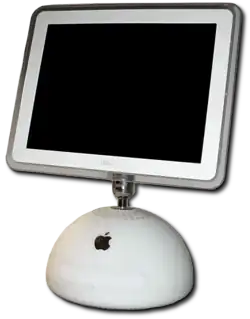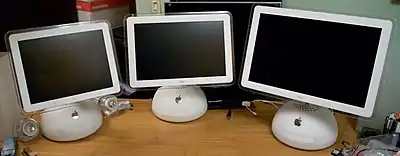 iMac G4 with a 15" screen | |
| Manufacturer | Apple Computer |
|---|---|
| Product family | iMac |
| Type | All-in-one |
| Release date | January 7, 2002 |
| Lifespan | January 7, 2002-August 31, 2004 (2 years and 237 days) |
| Introductory price | US$1,299 (equivalent to $2,113 in 2022) - US$1,799 (equivalent to $2,927 in 2022)[1] |
| Discontinued | August 31, 2004 |
| Predecessor | iMac G3 |
| Successor | iMac G5 |
The iMac G4 is an all-in-one personal computer designed, manufactured, and sold by Apple Computer from January 2002 to August 2004. It was announced at Macworld San Francisco in January of 2002. It replaced the iMac G3 and was succeeded by the iMac G5.
The iMac G4 was the first iMac to have an LCD display built in, replacing the CRT display of previous iMacs.
Design and marketing

The iMac G4 featured an LCD mounted on an adjustable arm above a hemisphere containing a full-size, tray-loading optical drive and a fourth-generation PowerPC G4 74xx-series processor. The internals such as the hard drive and motherboard were placed in the "dome" instead of the LCD panel as it would be too heavy. The arm allowed the display to hold almost any angle around the dome-shaped bottom. The iMac G4 was sold only in white, and was not translucent like the iMac G3. The machine was sold with the ice-white Apple Pro Keyboard and Apple Pro Mouse, which were later redesigned and renamed the Apple Keyboard and Apple Mouse, respectively. Optional Apple Pro Speakers, which were better quality than the internal speakers, were also available. The Apple Pro Speakers used a unique adapter, designed to work only with a select few Apple Macintosh models.
The iMac G4 originally included both Mac OS 9 and Mac OS X, due to the machine being released in the year Mac OS 9 was discontinued. When running newer versions of Mac OS X (Tiger and Leopard), the iMac G4's GeForce4 MX GPU was not capable of Core Image rendering. This causes some minor graphical issues. One such issue would be the lack of the Dashboard ripple effect when a widget is introduced. Another would be an opaque menu bar in Mac OS X Leopard.
It was originally known as the New iMac, while the existing iMac G3 continued to be sold for several months. During this time, Apple had all but eliminated CRT displays from its product line. However, the LCD iMacs were unable to match the low price point of the iMac G3, largely due to the higher cost of the LCD technology at the time. The iMac G3 was obsolete by this point, but low-cost machines were particularly important for the education market. Because of this affordability issue, Apple created the eMac in April 2002 and ended production of the iMac G3. The iMac G4 was then marketed as the "iMac" until its discontinuation, then was retroactively labeled iMac G4 to distinguish itself from the succeeding iMac G5 in August 2004.
Apple advertised the iMac G4 as having the adjustability of a desk lamp. One of the advertisements for the machine featured it sitting in a store window "reacting" to every move made by a passer-by on the street. At the end, when the man sticks out his tongue, the iMac responds by opening its optical drive.[2]
The internal components are housed in a 10.6" half-sphere, ice white case with a chromed stainless steel neck that supports a 15" TFT active matrix LCD display. Unlike some earlier iMac models that are convection-cooled, the iMac "Flat Panel" series is cooled by a quiet internal fan. The original model from 2002 shipped with Mac OS X 10.1 and Mac OS 9.2.2 preinstalled with Mac OS X selected as the default OS.
The Gateway Profile was one of the few Wintel competitors to the iMac G4 in the all-in-one LCD computer market. A reviewer noted that the Profile had better processing power, due to its Intel Pentium 4, whereas the iMac was hampered because its G4 chip lacked the 1 MB L2 cache found on the higher-end Power Mac. The iMac had clear advantages in LCD screen quality (it uses a digital LCD as opposed to an analog LCD), ergonomics (particularly the flexible monitor arm), and multimedia. The reviewer concluded that the iMac worked well as an introduction to the Macintosh ecosystem, but noted that their relatively high prices were approaching that of laptops, which were portable and had higher resolution LCD screens.[3]
Specifications
| Model | Flat Panel[4] | Mac OS X Only Flat Panel | 1.0 GHz Flat Panel[5] | Flat Panel USB 2.0 | ||||||
|---|---|---|---|---|---|---|---|---|---|---|
| Timetable | Released | January 7, 2002[6] | July 17, 2002[6] | February 4, 2003[6] | September 8, 2003[6] | November 18, 2003[6] | ||||
| Discontinued | February 4, 2003[6] | September 8, 2003[6] | July 1, 2004[6] | |||||||
| Model | Model number | M6498 (EMC 1873) | M6498 (EMC 1936) | M6498 (EMC N/A) | M6498 (EMC 1956) | M6498 (EMC 1990) | M6498 (EMC 1991) | M6498 (EMC 1992) | ||
| Model Identifier | PowerMac4,2 | PowerMac4,5 | PowerMac4,2 | PowerMac6,1 | PowerMac6,3 | |||||
| Apple Order No. | M8672 | M7677 | M8535 | M8812 | M9105 | M8935 | M9285 | M9168 | M9290 | |
| Display | 15" TFT LCD 1024×768 | 17" TFT Widescreen LCD 1440×900 | 15" TFT LCD 1024×768 | 17" TFT Widescreen LCD 1440×900 | 15" TFT LCD 1024×768 | 17" TFT Widescreen LCD 1440×900 | 20" TFT Widescreen LCD 1680 x 1050 | |||
| Performance | Processor | PowerPC 7450 (G4) | PowerPC 7445 (G4) | |||||||
| Clock speed | 700 MHz | 800 MHz | 1.0 GHz | 1.25 GHz | ||||||
| Cache | 64 KB L1, 256 KB L2 (1:1) | |||||||||
| Front Side Bus | 100 MHz | 133 MHz | 167 MHz | |||||||
| Memory | 128 MB of PC133 SDRAM | 256 MB of PC133 SDRAM | 128 or 256 MB of PC133 SDRAM | 256 MB of PC133 SDRAM | 256 MB of PC2100 (266 MHz) DDR SDRAM | 256 MB of PC2700 (333 MHz) DDR SDRAM | ||||
| Expandable up to 1 GB via one factory installed memory module in a 168-pin DIMM slot and one 144-pin user-accessible SO-DIMM slot. | Expandable up to 2 GB via one factory installed memory module in a 184-pin DIMM slot and one 200-pin user-accessible SO-DIMM slot. (officially only 1 GB is supported) | |||||||||
| Graphics | Nvidia GeForce 2 MX 32 MB of DDR SDRAM[7] |
Nvidia GeForce 4 MX 32 MB of DDR SDRAM[7] |
Nvidia GeForce 2 MX 32 MB of DDR SDRAM |
Nvidia GeForce 4 MX 64 MB of DDR SDRAM |
Nvidia GeForce 4 MX 32 MB of DDR SDRAM[7] |
Nvidia GeForce FX 5200 Ultra 64 MB of DDR SDRAM | ||||
| Storage | Hard drive | 40 GB, 60 GB, 80 GB | ||||||||
| Optical drive | 32x CD-R and 10x CD-RW write CD-RW Drive | 8x DVD and 32x CD read Combo drive | 6x DVD and 24x CD read; 2x DVD-R, 8x CD-R, and 4x CD-RW write SuperDrive | 32x Combo drive | 4x SuperDrive | 32x Combo drive | 4x SuperDrive | |||
| Connectivity | Network | 10BASE-T/100BASE-TX Ethernet 56k V.90 modem Optional 11 Mbit/s AirPort 802.11b |
10BASE-T/100BASE-TX Ethernet 56k V.92 modem Optional 11 Mbit/s AirPort 802.11b |
10BASE-T/100BASE-TX Ethernet 56k V.92 modem Optional Bluetooth 1.1 Optional 54 Mbit/s AirPort Extreme 802.11b/g | ||||||
| Peripherals | 3x USB 1.1 2x FireWire 400 Built-in microphone Audio out Apple Pro Speakers mini-jack |
3x USB 2.0 2x FireWire 400 Built-in microphone Audio out Apple Pro Speakers mini-jack | ||||||||
| Video out | Mini-VGA | |||||||||
| Maximum Operating System | Mac OS X 10.4.11 "Tiger" and Mac OS 9.2.2 | Mac OS X 10.4.11 "Tiger" or Mac OS 9.2.2 (With a patched image only[8]) | Mac OS X 10.5.8 "Leopard", or Mac OS X 10.4.11 "Tiger" with Mac OS 9.2.2 (Classic Mode only) | Mac OS X 10.5.8 "Leopard" | ||||||
| Weight | 21.3 lb. / 9.7 kg | 22.8 lb. / 10.4 kg | 21.3 lbs. / 9.7 kg | 22.8 lbs. / 10.4 kg | 21.3 lb. / 9.7 kg | 22.8 lb. / 10.4 kg | 40.1 lb. / 18.2 kg | |||
Timeline of iMac models
| Timeline of iMac and eMac models (sorted by screen sizes) |
|---|
 |
References
- ↑ https://www.macworld.com/article/218460/the-exceptional-imac-g4-ten-years-later.html#:~:text=At%20launch%20in%20January%202002,end%20model%20for%20%241799%20that
- ↑ iMac G4 TV commercial from 2001 on YouTube
- ↑ "Review: Gateway Profile 4 vs. Apple iMac". November 12, 2002. Archived from the original on October 25, 2008. Retrieved June 24, 2007.
- ↑ "Apple Unveils the New iMac". January 7, 2002. Archived from the original on May 15, 2007. Retrieved February 26, 2007.
- ↑ "Apple Announces Faster iMacs". September 8, 2003. Archived from the original on November 16, 2010. Retrieved July 18, 2010.
- 1 2 3 4 5 6 7 8 "Mac Systems > Apple > iMac". EveryMac.com. Archived from the original on April 3, 2022. Retrieved March 31, 2022.
- 1 2 3 "iMac (USB 2.0) – Technical Specifications". Apple. Archived from the original on November 28, 2014. Retrieved January 16, 2018.
- ↑ "Mac OS 9.2.2 for Previously Unsupported G4s (G4s that shipped OS X Boot Only)".